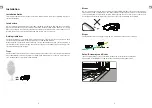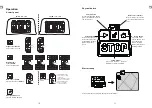
4
5
GB
GB
If the driveway and lawn are at the same level, feel free to use the boundary wire to create a
corridor. This allows your Robotic Mower to cross the driveway and reach the opposite lawn.
Uneven lawn surfaces
Uneven lawn areas or may cause the blades to touch the ground. We recommend leveling the
lawn before using your Robotic Mower or excluding uneven areas with the boundary wire.
Placing the docking station
Locate the best position for your docking station. Be aware that it needs a permanent connection
to the mains, so take into account the location of the nearest power outlet.
To ensure the Robotic Mower can return to the docking station smoothly, leave 2m of straight
wire to the front of the docking station and 50cm to the side facing the cutting area. Use a shaded
location for the docking station, as a lower temperature while charging is beneficial to the battery.
Important: Place the docking station on an even, flat surface away from ponds, pools or stairs.
We recommend suitable protection from the elements, for example a robot port or garage.
Do not place the docking station too close to a slope, such as at the top of a hill or the bottom of
a furrow. Avoid left and right inclination in excess of 5 degrees.
>5°
>5°
If your lawn has a soft or uneven surface, we recommend fortifying the area around the docking
station with a grass protection mesh. Otherwise, the repeated stress of the rear wheels can
damage the turf.
Once the position of the docking station is confirmed and mains electrical connection is laid out,
please do not connect to main power yet. Finish all boundary layout work before connecting the
docking station to the power supply.
Pegging your boundary wire
We strongly recommend mowing the lawn to 60 mm or less before laying out the boundary
wire. Burying the boundary wire is entirely optional. Still, the closer to the ground you lay out the
boundary wire, the lower the chance of tripping over it or damaging it when mowing the lawn.
Use the included ruler to ensure the required 20-30 cm distance between wire and obstacles.
20-30cm
20-30cm
20-30cm
50cm
The recommended distance between two pegs is about 80 cm in straight lines, and less in tight
curves. Note that the pegs' hook and wire slit always faces the outside of the boundary.
80cm
80cm
































